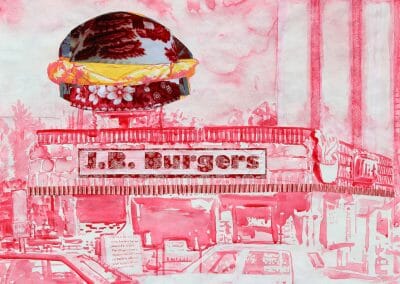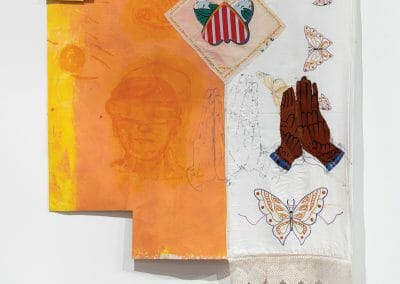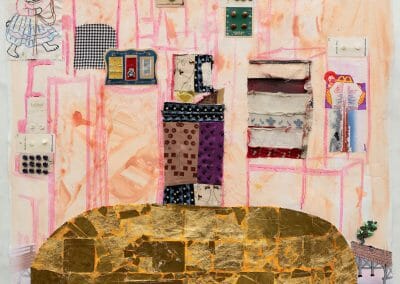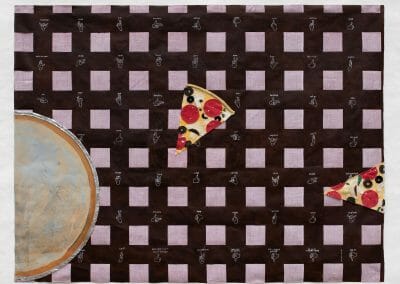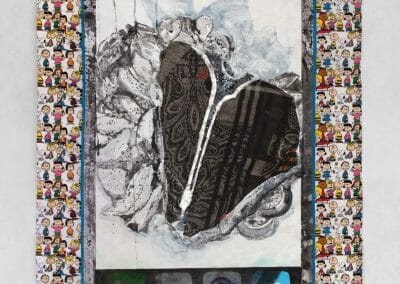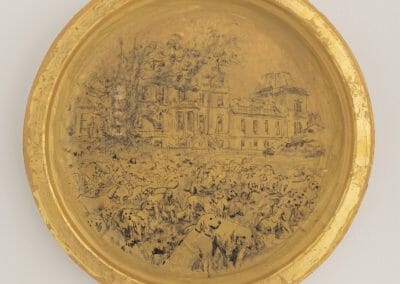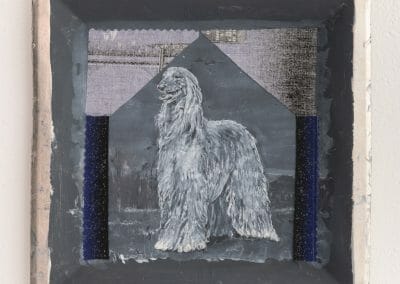
JULIE GREEN
AT HOME WITH FAMILY
December 8, 2021 – January 22, 2022
Who did you eat with? What did you have? Julie Green’s latest series asks these questions—quite literally—with their matter-of-fact cast belying the significance of the answers Green renders in vibrant acrylic on Tyvek. For the past three years, Green had been asking wrongfully convicted persons about their “first meals” upon their release from prison, painting their responses for Green’s series by the same name. From December 8, 2021 to January 22, 2022, 13 of the 30 paintings Green had completed at her death this past October are on view in At Home with Family, marking Elizabeth Houston Gallery’s 50th exhibition.
Known for The Last Supper, Green’s decades-long art project documenting the final meals of death row prisoners, Green has long searched for the human face in an inhumane carceral system. Green planned to paint last meals on plates—their substrate of choice—indefinitely or until capital punishment had been abolished in the United States for at least 20 years. In September, Green made what would be their last plate, depicting a glass bottle of Coca-Cola on a small oval dish (a modest request from a prisoner executed in Texas in 1997). 800 of the 1,000 works Green completed are now on display through late 2022 at the Bellevue Arts Museum in Washington state. Begun as a corollary to The Last Supper, Green’s First Meals similarly strives to represent that which is beyond the scope of representation—the staggering cruelties of wrongful incarceration—through the shared experience of breaking bread.
Drawing on craft and handiwork traditions, Green’s First Meals appear at first glance to be patchwork flags stitched together with various fabrics, 24k gold, found samplers, turmeric-dyed silk, and more, all sewn onto Tyvek, that hardy synthetic material used to wrap buildings under construction. Inspired by flow blue, a type of transferware that originated in Staffordshire, England in the early 19th century, Green’s plates pair the pastoral scenes of their progenitors with the realities (and symbols) of food eaten by newly freed prisoners. Oranges, burgers and fries, milk shakes, squash lasagna, rainbow trout, pizza, shrimp and grits, and corned beef, consumed alone or with family, at home or in diners, appear in acrylic and glow-in-the-dark paint. Inscribed around each plate are intimate details about each person: “17 years on death row, 1st meal on the outside, then threw up,” “Thank God I’m home,” sign language, “There’s no fast food in prison,” restaurant logos, even the one-page questionnaire Green distributed to participants.
But Green’s work is not about food—or not only about food—but its resonant symbolism in our lives together. Food here is a measure of time, time spent wrongfully imprisoned, with family around the dinner table, or making simple, but free choices that so many of us take for granted. Food is a timeless metaphor for pleasure and sustenance, as much as it is both, and its presence here serves as a reminder of its absence behind bars. Green’s emphasis on such personal, historical, and political details is reflected in Fashion Plates, a series of paintings in acrylic and glow-in-the-dark paint on Chinet paper plates. While The Last Supper had prioritized men’s experiences—as men are almost exclusively the subjects of capital punishment in the US—Fashion Plates considers women’s identities, with facsimiles of their thumbprints stamped on the versos. On view in At Home with Family, 10 of those plates provide a counterbalance, exploring the domestic sphere, a sense of security, and the practice (and meaning) of fingerprinting.
Partnering with the Center on Wrongful Convictions at Northwestern University and The Innocence Project, Green’s focus extends beyond the individual meals (and individuals) they depict to the sheer number of wrongfully imprisoned in this country. In 2020, the National Registry of Exonerations reported that police or prosecutor misconduct had led to convictions in more than half of the 2,400 exonerations documented nationwide over the last three decades. Green has been acutely aware of these realities, but their work has long conveyed them through experiences we all share. In doing so, it reminds us in an immediate way that the statistics represent actual people—many of them innocent of any crimes—caught in the carceral system. And as Green shows us, they are people who have had their most basic freedoms—as basic as choosing what to eat—stripped from them.
– Robyn Day
Robyn Day is a Chicago-based photographer and freelance writer for Photograph Magazine. She previously wrote art criticism for WBUR, Boston’s NPR news station, and Art New England.
Julie Green, professor of art at Oregon State University, lived in the Willamette Valley, Oregon. A recipient of the Joan Mitchell Foundation Grant for Painters and Sculptors and the Hallie Ford Foundation Fellowship, Green is included in A World of Art published by Prentice Hall. Green has had forty-two solo exhibitions in the U.S. and abroad at venues including The Block Museum at Northwestern University, Hunter Museum of American Art, Bellevue Arts Museum in Washington and University of Liverpool Art Museum. Collections include State Library of Oregon, Spencer Museum of Art, Fidelity Investments, Athena Art Finance, and hundreds of private collections worldwide. Green’s work has been featured in publications including The New York Times, Washington Post, the Los Angeles Times, Rolling Stone, CNN, a Whole Foods mini-documentary, National Public Radio, and Ceramics Monthly.
Upcoming exhibitions of First Meal include solo exhibition: Thank God, I’m Home at The NJCU Harold Lemmerman Gallery, Jersey City, NJ from February 1 – March 25, 2022 and a group exhibition of Hallie Ford Fellows, The Ford Family Foundation at Oregon Contemporary in early 2022. Her forthcoming book, a visual essay of Julie Green’s First Meal from Oregon State University Press is to be released in Fall 2022 with New York Times Journalist, Kirk Johnson. Julie Green’s estate is represented by UPFOR.
